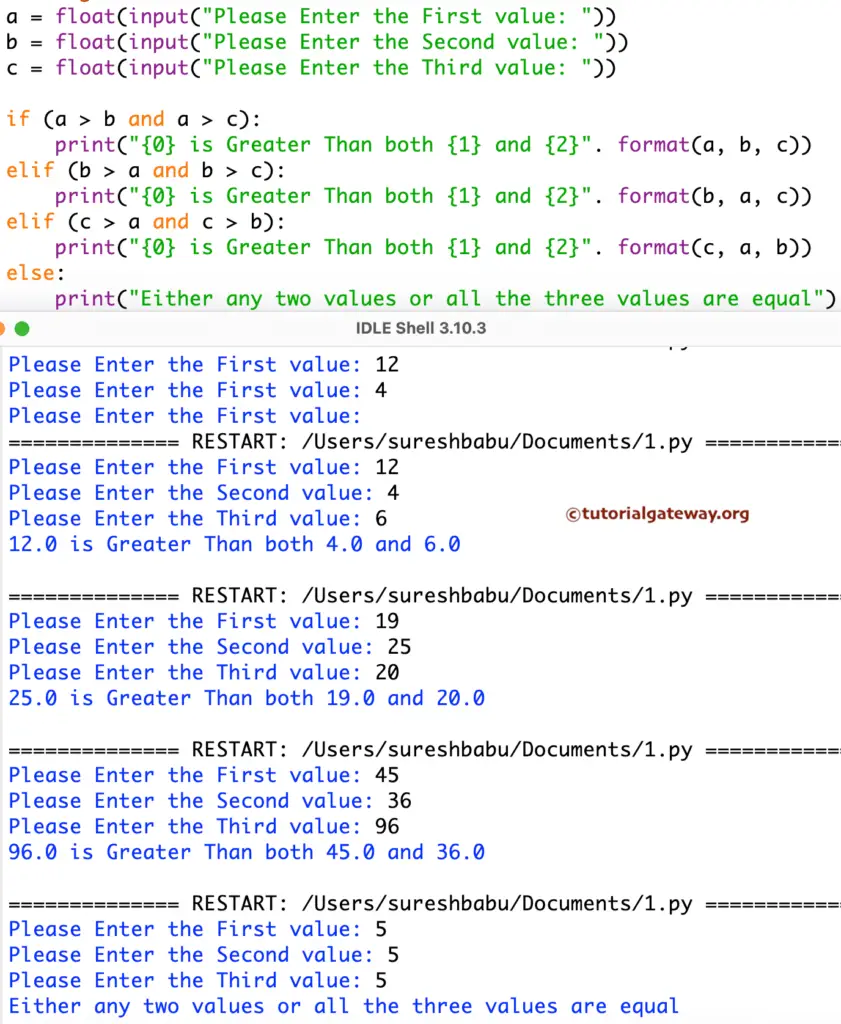Write a Python program to find the largest of three numbers using Elif Statement and Nested If. There are many approaches to finding the largest number among the three numbers, and we discuss all of them.
Python Program to find Largest of Three numbers using elif Statement
This program helps the user to enter three different values. Next, this Python program will find the largest among that three numbers using Elif Statement
# using elIf Statement
a = float(input("Please Enter the First value: "))
b = float(input("Please Enter the First value: "))
c = float(input("Please Enter the First value: "))
if (a > b and a > c):
print("{0} is Greater Than both {1} and {2}". format(a, b, c))
elif (b > a and b > c):
print("{0} is Greater Than both {1} and {2}". format(b, a, c))
elif (c > a and c > b):
print("{0} is Greater Than both {1} and {2}". format(c, a, b))
else:
print("Either any two values or all the three values are equal")
First, we entered values a = 12, b = 4, and c = 6. Next, we entered values a = 19, b = 25, and c = 20. Next, we entered values a = 45, b = 36, and c = 96. Finally, we entered the values a = 5, b = 5, c= 5.
The output of the above Python Program to Find the Largest of Three Numbers examples is as follows.

In this Python Program to Find the Largest, the first three lines of code ask the user to enter three numbers and store the user entered values in variables a, b and c
Within this program, the First if condition checks whether a is greater than b and a is greater than c. If both of these are True, the following print statement will be displayed (a is greater than both b, c).
if (a > b and a > c):
print("{0} is Greater Than both {1} and {2}". format(a, b, c))
The first Elif Statement statement checks whether b is greater than a and b is greater than c. If both are True, the following print statement will be displayed ( b is greater than both a, c).
elif (b > a and b > c):
print("{0} is Greater Than both {1} and {2}". format(b, a, c))
The second Elif statement checks whether c is greater than a and c is greater than b. If both are True, the following print statement will be displayed ( c is greater than both a, b).
elif (c>a and c>b):
print("{0} is Greater Than both {1} and {2}". format(c, a, b))
If all the above Python conditions fail, it means they are equal.
print("Either any two values or all the three values are equal")
Python Program to Find Largest of Three numbers using Nested If Statement
This program helps the user to enter three different values. Next, this Python program will find the largest number among those three using the Nested If statement.
# using Nested If Statement
a = float(input("Please Enter the First value: "))
b = float(input("Please Enter the First value: "))
c = float(input("Please Enter the First value: "))
if (a-b > 0) and (a-c > 0):
print("{0} is Greater Than both {1} and {2}". format(a, b, c))
else:
if(b - c > 0):
print("{0} is Greater Than both {1} and {2}". format(b, a, c))
else:
print("{0} is Greater Than both {1} and {2}". format(c, a, b))
Within this Python Program to Find the Largest of Three Numbers, First, we entered the values a= 32, b= 45, c= 98. Next, we entered the values a= 22, b= 5, c= 7. And finally, we entered the values a= 56, b= 222, c= 98

Within this Python Program to Find the Largest, the first three statements ask the user to enter three numbers and store the user entered values in variables a, b and c
The First if condition checks whether a-b is greater than 0 and a-c is greater than 0. This condition fails if we subtract a small number from a big one. Otherwise, it will be True. If this condition is True, then a is greater than both b and c.
if (a-b> 0) and (a-c > 0):
print("{0} is Greater Than both {1} and {2}". format(a, b, c))
Else statement will execute when the first If condition is False, so there is no need to check for a value. In the Else statement, we insert one more if condition (Nested If) to check whether b-c is greater than 0. If this condition is True, then b is greater than both a, c.
else:
if(b- c> 0):
print("{0} is Greater Than both {1} and {2}". format(b, a, c))
Else c is greater than both a, b.
print("{0} is Greater Than both {1} and {2}". format(c, a, b))

Comments are closed.